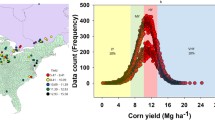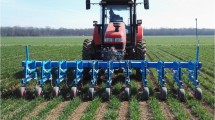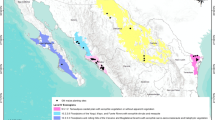Abstract
The ability to plant two or more hybrids during a single planting operation (i.e., multi-hybrid planting) has the potential to mitigate in-field yield variation caused by soil, disease pressures, environmental and water conditions. A multi-hybrid planting platform was utilized to conduct on-farm research trials in ten eastern Nebraska fields in 2016 and 2017. Trials focused on placement of an offensive versus defensive (i.e., drought tolerant) maize hybrid, largely based on soil type and water availability interactions. Management zones were created through use of Management Zone Analyst to cluster correlated data layers, including historic yield, soil texture and electrical conductivity maps into zones. Hybrid placement and zone delineation effectiveness were assessed through in-season vegetative index readings and yield comparisons after harvest. Above average growing season rainfall led to mixed yield results for both growing seasons with six sites showing no difference in hybrid-by-zone placement and four sites indicating a single hybrid outperformed the multi-hybrid approach. Results indicated a single hybrid should have been planted within each field to optimize economic return. In several fields, however, there was no negative consequence for planting a defensive hybrid which could provide a level of yield protection during drier years. Zone scenarios were created for each field to find correct zone delineation and hybrid placement for the respective growing season. Optimum hybrid placement was derived for each site using post processing and spatial interpolation techniques, however further validation across more site-years would mitigate the high amounts of temporal variability due to the growing seasons studied.








Similar content being viewed by others
Change history
24 March 2023
A Correction to this paper has been published: https://doi.org/10.1007/s11119-023-10011-1
References
Bullock, D. G., Bullock, D. S., Nafziger, E. D., Doerge, T. A., Paszkiewicz, S. R., Carter, P. R., et al. (1998). Does variable rate seeding of corn pay? Agronomy Journal, 90(6), 830–836. https://doi.org/10.2134/agronj1998.00021962009000060019x
Dobermann, A., Ping, J. L., Adamchuk, V. I., Simbahan, G. C., & Ferguson, R. B. (2003). Classification of crop yield variability in irrigated production fields. Agronomy Journal, 95(5), 1105–1120. https://doi.org/10.2134/agronj2003.1105
Doerge, T. A., & Gardner, D. L. (1999). On-farm testing using the adjacent strip comparison method. In Robert, P. C., Rust, R. H. & Larson, W. E. (Eds.) Proceedings of the Fourth International Conference on Precision Agriculture (pp. 603–609). Madison, WI, USA: ASA, CSSA, SSSA. https://doi.org/10.2134/1999.precisionagproc4.c59
Dudding, J. P., Robert, P. C., & Bot, D. (1995). Site-specific soybean seed variety management in iron chlorosis inducing soils. Agronomy Abstract (p. 291). Madison, WI, USA: ASA, CSSA, and SSSA,.
Fraisse, C. W., Sudduth, K. A., & Kitchen, N. R. (2001). Delineation of site-specific management zones by unsupervised classification of topographic attributes and soil electrical conductivity. Transactions of the ASABE, 44(1), 155–166. https://doi.org/10.13031/2013.2296
Fridgen, J. J., Kitchen, N. R., Sudduth, K. A., Drummond, S. T., Wiebold, W. J., & Fraisse, C. W. (2004). Management zone analyst (MZA): Software for subfield management zone delineation. Agronomy Journal, 96(1), 100–108. https://pubag.nal.usda.gov/catalog/8380
HPRCC (2022). High Plains Regional Climate Center Data Services. Retrieved January 2022 from https://hprcc.unl.edu/onlinedataservices.php
iGrow Corn (2019). Best management practices Chap. 1: Developing a strategy to achieve 300 bushel corn per acre or incrementally increasing current yields. South Dakota State University Extension. Retrieved October 2022 from https://extension.sdstate.edu/sites/default/files/2019-09/S-0003-01-Corn.pdf
Jaynes, D. B., & Colvin, T. S. (1997). Spatiotemporal variability of corn and soybean yield. Agronomy Journal, 89(1), 30–37. https://doi.org/10.2134/agronj1997.00021962008900010005x
Jaynes, D. B., Colvin, T. S., & Kaspar, T. C. (2005). Identifying potential soybean management zones from multi-year yield data. Computers and Electronics in Agriculture, 46(1–3), 309–327. https://doi.org/10.1016/j.compag.2004.11.011
Katsvairo, T. W., Cox, W. J., Van Es, H. M., & Glos, M. (2003). Spatial yield response of two corn hybrids at two nitrogen levels. Agronomy Journal, 95(4), 1012–1022. https://doi.org/10.2134/agronj2003.1012
Kitchen, N. R., Sudduth, K. A., Myers, D. B., Drummond, S. T., & Hong, S. Y. (2005). Delineating productivity zones on claypan soil fields using apparent soil electrical conductivity. Computers and Electronics in Agriculture, 46(1–3), 285–308. https://doi.org/10.1016/j.compag.2004.11.012
Klein, R., Wilson, R., Groskoph, J., & Jansen, J. (2017). 2018 Nebraska Crop Budgets. Institute Agriculture & Natural Resources. Retrieved October 2022 from https://cropwatch.unl.edu/budgets
Koch, B., & Khosla, R. (2003). The role of precision agriculture in cropping systems. Journal of Crop Production, 9(1–2), 361–381. https://doi.org/10.1300/J144v09n01_02
Lamb, J. A., Dowdy, R. H., Anderson, J. L., & Rehm, G. W. (1997). Spatial and temporal stability of corn grain yields. Journal of Production Agriculture, 10(3), 410–414. https://doi.org/10.2134/jpa1997.0410
Lark, R. M., Bolam, H. C., Mayr, T., Bradley, R. I., Burton, R. G. O., & Dampney, P. M. R. (1999). Analysis of yield maps in support of field investigations of soil variation. In Stafford, J. V. (Ed.) Precision Agriculture ’99, Part 1 and Part 2. Proceedings of the 2nd European Conference on Precision Agriculture, (pp 151–161) Sheffield, UK: Sheffield Academic Publishers.
Licht, M. A., Lenssen, A. W., & Elmore, R. W. (2017). Corn (Zea mays L.) seeding rate optimization in Iowa, USA. Precision Agriculture, 18(4), 452–469. https://doi.org/10.1007/s11119-016-9464-7
McCann, B. L., Pennock, D. J., van Kessel, C., & Walley, F. L. (1996). The development of management units for site-specific farming. ASA, CSSA, and SSSA Books. Hoboken, U.S.A. Wiley. https://doi.org/10.2134/1996.precisionagproc3.c33
Mercer, W. B., & Hall, A. D. (1911). The experimental error of field trials. The Journal of Agricultural Science, 4(2), 107–132. https://doi.org/10.1017/S002185960000160X
Miao, Y., Mulla, D. J., Robert, P. C., & Hernandez, J. A. (2006). Within-field variation in corn yield and grain quality responses to nitrogen fertilization and hybrid selection. Agronomy Journal, 98(1), 129–140. https://doi.org/10.2134/agronj2005.0120
Moral, F. J., Terrón, J. M., & Silva, J. R. M. (2010). da. Delineation of management zones using mobile measurements of soil apparent electrical conductivity and multivariate geostatistical techniques. Soil and Tillage Research, 106(2), 335–343. https://doi.org/10.1016/j.still.2009.12.002
Odeh, I. O. A., McBratney, A. B., & Chittleborough, D. J. (1992). Soil pattern recognition with fuzzy c-means: application to classification and soil-landform interrelationships. Soil Science Society Of America Journal, 56, 505–516. https://doi.org/10.2136/sssaj1992.03615995005600020027x
Pierce, F. J., & Nowak, P. (1999). Aspects of precision agriculture. In D. L. Sparks (Ed.), Advances in Agronomy (Vol. 67, pp. 1–85). New York, U.S.A. Academic Press. https://doi.org/10.1016/S0065-2113(08)60513-1
Schepers, A. R., Shanahan, J. F., Liebig, M. A., Schepers, J. S., & Johnson, S. H. (2004). Appropriateness of management zones for characterizing spatial variability of soil properties and irrigated corn yields across years. Agronomy Journal, 96(1), 195–203. https://doi.org/10.2134/agronj2004.1950. Jr.
Shanahan, J. F., Doerge, T. A., Johnson, J. J., & Vigil, M. F. (2004). Feasibility of site-specific management of corn hybrids and plant densities in the great plains. Precision Agriculture, 5(3), 207–225. https://doi.org/10.1023/B:PRAG.0000032762.72510.10
Stafford, J. V., Lark, R. M., & Bolam, H. C. (1999). Using yield maps to regionalize fields into potential management units. In Robert, P. C., Rust, R. H. & Larson, W. E. (Eds.) Proceedings of the Fourth International Conference on Precision Agriculture. (pp 225–237). https://doi.org/10.2134/1999.precisionagproc4.c20
Stevens, R. H. (2018). Application of a multi-hybrid planter for geospatial assessment of zone-based corn hybrid and soybean seed treatment performance for optimized crop production. MS thesis. Lincoln, Nebraska, USA: University of Nebraska-Lincoln, Department of Biological Systems Engineering.
Stringfield, G. H. (1964). Objectives in corn improvement. In A. G. Norman (Ed.), Advances in Agronomy (Vol. 16, pp. 101–137). New York, U.S.A. Academic Press. https://doi.org/10.1016/S0065-2113(08)60022-X
Sudduth, K. A., Drummond, S. T., & Myers, D. B. (2012). Yield Editor 2.0: Software for automated removal of yield map errors. Paper No. 12-1338243 St Joseph, MI, USA: ASABE. https://doi.org/10.13031/2013.41893
Ward, J. K., Henry, W. B., & Hock, M. W. (2016). Variability in Harvest Moisture and Dry-Down in Multi-Hybrid planting Systems. Transactions of the ASABE, 59(5), 1111–1115. https://doi.org/10.13031/trans.59.11572
Weil, R., & Brady, N. (2017). The Nature and Properties of Soils. 15th edition. New York, U.S.A. Pearson.
Acknowledgements
The authors would like to acknowledge the financial support of the United States Department of Agriculture National Institute of Food and Agriculture, Hatch Project #1009760. Any opinions, findings, conclusions, or recommendations expressed in this publication are those of the author(s) and do not necessarily reflect the view of the U.S. Department of Agriculture.
Author information
Authors and Affiliations
Corresponding author
Ethics declarations
Conflict of interest
The authors declare that they have no conflict of interest.
Additional information
Publisher’s Note
Springer Nature remains neutral with regard to jurisdictional claims in published maps and institutional affiliations.
The original version of the article was revised: Orders of authors were corrected.
Rights and permissions
Springer Nature or its licensor (e.g. a society or other partner) holds exclusive rights to this article under a publishing agreement with the author(s) or other rightsholder(s); author self-archiving of the accepted manuscript version of this article is solely governed by the terms of such publishing agreement and applicable law.
About this article
Cite this article
Stevens, R., Luck, J.D., Evans IV, J. et al. Site-specific zone delineation for varying Maize Hybrids based on field variability: a multi-hybrid planting application case study in eastern Nebraska. Precision Agric 24, 879–896 (2023). https://doi.org/10.1007/s11119-022-09978-0
Received:
Accepted:
Published:
Issue Date:
DOI: https://doi.org/10.1007/s11119-022-09978-0




